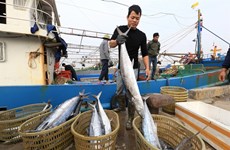Quang Ninh has first model new style rural commune
Viet Dan commune in Dong Trieu township has become the first model new style rural commune in the northern province of Quang Ninh after fulfilling advanced criteria for a new style rural area.

 Locals in Viet Dan commune proactively join hands to build model new style area. (Photo: VNA)
Locals in Viet Dan commune proactively join hands to build model new style area. (Photo: VNA)Quang Ninh (VNA) – Viet Dan commune in Dong Trieu township has become the first model new style rural commune in the northern province of Quang Ninh after fulfilling advanced criteria for a new style rural area.
Standards for a model new-style rural commune issued are advanced criteria of the National Target Programme on New-style Rural Area Building.
According to Secretary of the Party Committee and Chairman of the People’s Committee of Viet Dan commune Do Dinh The, the commune has 270 hectares of orchard trees, most of the areas are planted with custard-apples.
The commune’s income per capita in 2018 reached 55.8 million VND (2,400 USD), doubling the figure recorded in 2015 when the commune was bestowed with the new-style rural area status, he said.
Besides, all of the local roads have been concretised, upgraded or repaired, while medical stations, kindergartens, primary schools were built in line with the national standards.
In the past time, a wide range of campaigns have been launched to encourage the involvement of local residents in building their model new-style rural area, including “lightening the rural roads” and “green Sunday”, among others.
Dong Trieu township has been a pioneer in the building of model new style rural areas after it was recognised as the first new style rural area in Quang Ninh in 2015.
Together with developing its Viet Dan, An Sinh and Binh Khe communes to become model new-style rural areas, Dong Trieu has worked hard to promote the building new-style rural area campaign in many other communes.
The township mobilised 1.8 trillion VND to develop local infrastructure, in which 800 billion VND came from individuals and organisations. Many local residents contributed thousands of square metres of land and thousands of man-days to construct model roads, gardens, and cultural houses.
Dong Trieu has 90 kilometres of rural roads, and 18 kilometres of concretised irrigational system. All of the communes have satisfied standards on power grid, as well as the rate of households with regular and safe use of electricity. More than 98 percent of local families have safe houses.
For production development projects, the township is developing the One Commune-One Product (OCOP) programme, while supporting projects to improve product quality, and branching out brands for local key products like custard-apple, litchi, and several flowers and ornamental trees in accordance with VietGAP standards.
Quang Ninh was the first locality in the country to implement the OCOP programme in 2013, and local OCOP products have been gaining popularity recently.
The province has mobilised more than 500 billion VND to support the development of products under the programme. By now 140 organisations have been involved in the OCOP scheme, developing 351 products, with 138 of them winning high-quality rating.
The OCOP programme has helped change local production practice towards commercial scale while facilitating market management. In fact, it is an economic development programme for rural areas focusing on increasing internal power and values, contributing to the implementation of the National Target Programme on New Rural Development for 2016-2020.
Last year, the by the Prime Minister issued criteria for model new-style rural commune in 2018-2020. There are four groups of criteria that a rural commune should meet in order to earn the title. They include criteria on production, income and household poverty rate, education, health care and culture, environmental protection, and security-order and public administrative service.
The National Target Programme on New-style Rural Area Building, initiated by the Government in 2010, sets 19 criteria on socio-economic development, politics, and defence, aiming to boost rural regions of Vietnam. The number of criteria was increased to 20 in 2015.
The list of criteria includes the development of infrastructure, the improvement of production capacity, environmental protection, and the promotion of cultural values.- VNA











